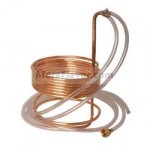Now that I have a propane cooker, I need to get some other equipment. The most important item is a wort chiller. Since I will be brewing a larger volume of wort, I need something that will cool this larger volume from just under boiling temperatures to fermentation temperatures (around 70 degrees).
When you first start out brewing your own beer, you boil a concentrated wort that ranges from 1 to 2 gallons for recipes that make 5 gallons of beer. After you are done boiling it, you add it to your fermentation vessel with enough plain ol’ water to make 5 gallons. As you probably can guess, it’s a lot easier and quicker to cool 1 to 2 gallons of almost boiling wort to 70 degrees. I would take my boiling pot and let it sit in my kitchen sink in an ice bath for about 10 minutes. While the pot was sitting there, I would take 3+ gallons of spring water that were cooled in the fridge and pour them into my fermantation bucket. Pouring my wort into this cool water always brought the wort to a temp where I could put my yeast in and not be afraid of killing the little guys.
Why do you need to cool the wort quickly? Well, the faster you can get the wort into the fermentation vessel (just fancy talk for bucket), introduce yeast, and seal it up, the less chance there is for wild yeast to get into your wort and make it taste funky. Quick cooling means more control over the final taste of the beer.
After some research, More Beer looks like it’s the place for me to buy this piece of equipment. The free shipping offer on orders over 59 bucks is the biggest reason I am ordering from this site.
Here’s a photo of the one I want:
I have some other items I want to buy too. Once I get a moment to order it, I will let you know how the experience is.Here’s a post about getting my wort chiller.


Kevin
I had a problem with wild yeast once. The doctor gave me a cream and in like two days it was all better.
John
Good sanitation practices should be followed always. Concentrate on the areas that are prone to contamination.